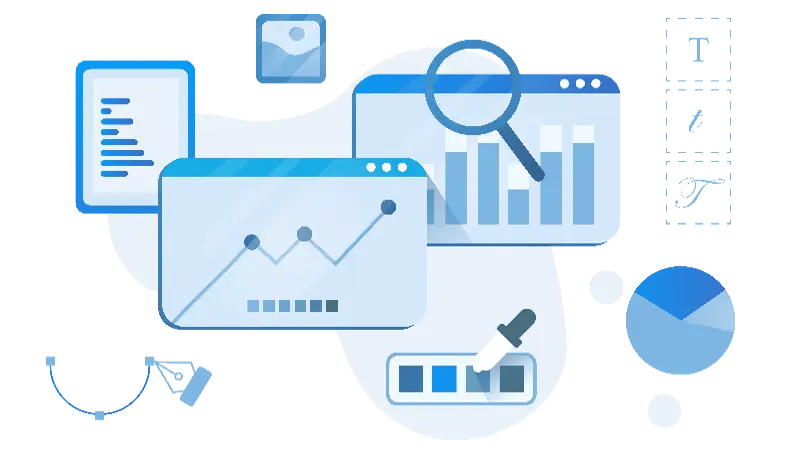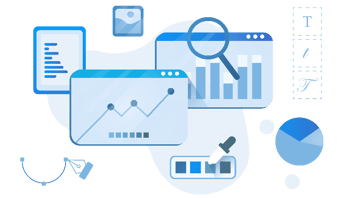What is a Launch Pad Website, and How Do I Set it Up Right?
Does the journey to launching your dream website seem endless? You're envisioning a site that's visually stunning and incredibly user-friendly.
Yet, achieving this feels like a marathon with no finish line. Good news for marketers feeling stuck in this cycle: launch pad websites offer a swift and efficient way to elevate your ideas!
What is a Launch Pad Website?
Imagine a website that's like the MVP (minimum viable product) of a car: it has an engine, wheels, and a steering wheel—the essentials to get you moving. That's the idea behind a launch pad website. It's a core website built with the essential functionalities to achieve your primary goals, focusing on the basic features and functionalities you need to launch quickly and achieve results.
This approach falls under Growth-Driven Design (GDD), a methodology that emphasizes continuous improvement based on real user data. Instead of spending months crafting a perfect website in a vacuum, GDD allows you to get a core website live quickly and then use user data to refine it over time.
Here's a breakdown of the key points:
-
Focus on Essentials: It includes only the core features and functionalities critical for your website's success, like lead generation forms, clear calls to action, and essential product information. Fancy bells and whistles come later.
-
Fast Launch: The development process is streamlined to get your website live quickly, minimizing time and cost compared to traditional website building.
-
Data-Driven Optimization: By launching early, you can collect real user data on how they interact with your website. This data is then used to refine and improve your website over time.
-
Iterative Process: A launch pad website isn't the final product; it's the starting point. GDD emphasizes continuous improvement based on user feedback and data analysis.
Why is this so valuable?
-
Studies show that 46% of businesses report taking more than six months to build a website.
For businesses looking to kick off their website presence sooner rather than later, six months can feel like an eternity. And time isn't the only factor.
-
The average cost of a website design project can range from $2,500 to $100,000+, depending on complexity and features.
Not all SMBs have those kinds of funds upfront - especially if their website hasn't launched yet to start bringing in revenue.
Launch pad website design is like testing the waters for your website. A launch pad website allows you to gauge user response to key features and content without a huge upfront investment. This data becomes your roadmap for future improvements, ensuring your website evolves and adapts to serve your audience's needs best.
Growth-Driven Design 101
Unlike the "build-it-and-launch-it" approach, Growth-Driven Design (GDD) prioritizes data-driven optimization and continuous improvement. Let's break it down:
Stage 1: Setting the Course (Strategy)
Before takeoff, any pilot needs a plan. Similarly, GDD starts with a strategic planning phase. This involves defining your target audience: who are you trying to reach with your website?
Next, you'll establish clear goals, like generating leads or increasing sales. Finally, you'll identify key performance indicators (KPIs), the metrics that will track your progress towards those goals.
Stage 2: Lift Off with a Launchpad Website
Imagine a streamlined airplane equipped with the essentials for flight – an engine, wings, and a cockpit. That's the essence of a launch pad website. GDD prioritizes building a core website with the most essential features and functionalities to achieve your goals. This could include clear calls to action, lead generation forms, and essential product information. GDD allows for a quicker launch by focusing on the core, minimizing development time and costs.
Stage 3: Soar Through Continuous Improvement
The launch pad website isn't the final destination; it's the beginning of your journey. GDD emphasizes gathering real user data once your website is live. This data reveals how users interact with your website: what pages are they visiting? What content resonates with them?
By analyzing this data, you can identify areas for improvement. GDD then encourages A/B testing different website elements and functionalities to see what works best. Based on the results, you can iterate and refine your website over time, ensuring it continuously improves and delivers the best possible experience for your audience.
GDD empowers you to move away from guesswork and embrace a data-driven approach to website development. By focusing on continuous improvement, you can create a website that evolves alongside your business and achieves lasting success.
The Launch Pad Advantage: Why Go Minimalist (For Now)?
In today's fast-paced digital world, speed and agility are crucial for success. Traditional website development processes can feel like dragging an anchor – lengthy design phases, endless revisions, and a seemingly never-ending runway before launch. This is where the launch pad website shines. By embracing minimalism for now, you unlock a multitude of advantages that can propel your online presence to new heights.
Faster Takeoff
Shave Months Off Your Launch Time
Imagine the frustration of waiting months for a website to take flight. The launch pad approach eliminates this delay. Development is streamlined by focusing on core functionalities rather than intricate design elements. This translates to a significantly faster launch time, allowing you to capture leads, generate sales, and establish your online presence sooner. Think of it as test-driving a car; you don't need all the bells and whistles to get moving in the right direction.
Data-Driven Decisions
Let Your Audience Guide Your Next Steps
One of the biggest challenges in website development is understanding what truly resonates with your audience. Traditional methods rely on guesswork and assumptions. The launch pad website flips the script. By launching with core functionalities, you can start collecting real user data as soon as you're live. This data reveals invaluable insights into user behavior – where they click, what content they engage with, and what areas might require improvement. With these insights in hand, you can make informed decisions about future website development, ensuring you're investing resources where they matter most.
Cost-Effective Development
Focus Resources Where They Matter
Website development can be a significant financial investment. The launch pad approach optimizes this investment by prioritizing core functionalities. Instead of spreading resources thin across every design element, you focus on the features that will directly impact your goals. This allows you to build a solid foundation for your website while saving resources for future enhancements based on user data. Think of it like building a house; a strong foundation is essential before adding decorative flourishes.
Reduced Risk
Experimentation Without Breaking the Bank
Website design is an evolving art form. What works today might not be optimal tomorrow. The launch pad website allows you to experiment with different design elements and functionalities on a smaller scale. This minimizes the risk of costly mistakes that can derail a traditional website development project. By gathering user data and testing variations, you can identify the most effective design choices to iterate and refine your website over time. It's like testing different paint colors on a single wall before repainting the entire house.
Adaptability and Agility
Evolve Alongside Your Audience
The launch pad website isn't a static entity; it's a springboard for continuous improvement. By gathering user data and observing user behavior, you can identify trends and adapt your website to serve your audience's needs better. This level of agility allows your website to evolve alongside your business and the ever-changing digital landscape.
The Power of Minimalism: A Launchpad for Success
The launch pad website isn't just about getting your website online quickly; it's about embracing a strategic approach to website development. You gain valuable insights by prioritizing essential functionalities and leveraging user data while minimizing risk and cost.
The art of going to market quickly is like flying an airplane under construction. While it needs wings to take off, those are not useful before it hits the runway.
This data-driven approach ensures your website evolves and adapts to meet your audience's needs, propelling you towards online success. So, the next time you envision a dream website, consider the launch pad approach. For now, embrace minimalism, gather valuable data, and watch your online presence take flight.
Building Your Launch Pad Website: A Step-by-Step Guide
1. Define Core Objectives
Imagine a pilot meticulously plotting their flight path. Similarly, the first step in building your launch pad website involves defining your core objectives. What are your website's absolute must-have features to fulfill its critical functions? Think about the primary goals you want your website to achieve:
-
Lead Generation: Do you want visitors to sign up for your newsletter, request a demo, or make a purchase? Craft clear calls to action and integrate lead capture forms to convert website visitors into valuable leads.
-
Brand Awareness: Is building brand recognition and establishing industry authority a priority? Develop compelling content that showcases your expertise and resonates with your target audience.
-
Increased Sales: Are you aiming to boost online sales? Design a user-friendly online store with clear product information, secure payment gateways, and a streamlined checkout process.
By clearly identifying your core objectives, you can prioritize the essential features your launch pad website needs to possess.
2. Prioritize Your Audience
Think of your website as a plane catering to a specific passenger type. You must understand your ideal website visitor to ensure a smooth and enjoyable journey. Here's how:
-
Develop a buyer persona: Create a detailed profile of your target audience. Consider their demographics, interests, pain points, and online behavior. Understanding their needs and challenges allows you to tailor your website content and features to resonate with them.
-
Identify their information needs: What information are your ideal visitors seeking when they land on your website? Ensure your website delivers this information clearly and concisely.
3. Craft Compelling Content
Engaging content is the lifeblood of any successful website. For your launch pad website, prioritize clarity and conciseness. Focus on writing content that:
-
Educates and informs: Provide valuable information that addresses your target audience's pain points and interests.
-
Guides users towards your goals: Direct website visitors towards taking desired actions, like contacting you for a consultation or subscribing to your newsletter.
-
Optimizes for search engines (SEO): Conduct keyword research and strategically integrate relevant keywords to improve your website's ranking in search engine results. This ensures your website reaches a wider audience.
4. Design for User Experience (UX)
Just as a cluttered airplane cabin creates a frustrating experience, a poorly designed website can alienate visitors. Here's how to ensure a user-friendly and customer-centric experience:
-
Prioritize intuitive navigation: Make it easy for visitors to find the necessary information. Implement a clear and concise navigation bar and utilize internal linking to connect relevant pages.
-
Visual appeal matters: While an overly complex design might be tempting, prioritize a clean and visually appealing layout. Use high-quality images and consistent branding elements to create a positive first impression.
-
Calls to action (CTAs) are your co-pilots: Don't leave visitors guessing what to do next. Include clear and concise CTAs throughout your website, guiding users toward taking the actions you desire.
5. Integrate Analytics
Imagine a pilot flying blind – not an ideal scenario. Similarly, you need data to understand how users interact with your launch pad website. Here's how to unlock valuable insights:
-
Set up analytics tools: Tools like Google Analytics provide a wealth of data about website traffic and user behavior—track metrics like page views, bounce rates, and conversion rates to identify areas for improvement.
-
Learn from user behavior: By analyzing user data, you can discover which pages resonate with your audience, where they encounter roadblocks, and what content might require further optimization.
Remember: At this stage, the launch pad website isn't about achieving design perfection. The goal is to create a functional website that fulfills your core objectives, gathers valuable user data, and serves as a springboard for future enhancements based on data-driven insights. By following these steps, you'll be well on your way to building a launchpad website that propels your online presence towards success.
Launch and Learn with a Growth-Driven Design Approach
The launch pad website isn't just a website; it's a springboard to a dynamic, data-driven online presence. By focusing on core functionalities and prioritizing your audience's needs, you can establish a website that generates leads, drives results, and fosters growth – all while minimizing development time and costs. Remember, Growth-Driven Design (GDD) isn't a one-time event; it's a continuous process.
The beauty of the GDD approach lies in its ability to create a website that evolves alongside your business. As your target audience grows and your business needs change, your website can adapt to meet those evolving demands. This ensures your website remains relevant and continues to deliver optimal results.
Want to leverage the power of Growth-Driven Design to build a launch pad website that propels your business forward? Aspiration Marketing specializes in crafting data-driven websites that generate results. Contact us today for a free consultation and see how we can help your website (and business) take flight!
This content is also available in:
- Deutsch: Was ist eine Launch Pad Website, und wie richte ich sie richtig ein?
- Español: ¿Qué es un Launch Pad Website y cómo configurarlo correctamente?
- Français: Qu'est-ce qu'un site web Launch Pad et comment l'organiser ?
- Italiano: Sito web Launch Pad: Cos'è e come configurarlo correttamente
- Română: Ce este un site Launch Pad și cum îl configurez corect?
- 简体中文: 什么是发射台网站,如何正确设置?










Leave a Comment